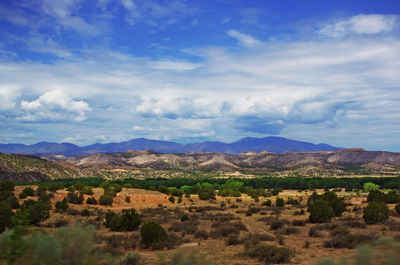New Mexico Counties
There is thirty-three counties in the state of New Mexico. There were originally nine counties formed in 1852. Santa Ana County, New Mexico Territory, one of the nine original counties, was annexed in 1876 to Bernalillo County, New Mexico.Catron County, New Mexico
Catron County Education, Geography, and History
Catron County is a county located in the state of New Mexico. Based on the 2010 census, the population was 3,725, making it the third-least populous county in New Mexico. Its county seat is Reserve. Catron County is the largest county by area in New Mexico.
Etymology - Origin of County Name
Named for Thomas B. Catron, a very prominent politician in New Mexico's history
Demographics:
County QuickFacts: CensusBureau Quick Facts
County History
Catron County was created 25 February 1921. It was named for New Mexico's first United States Senator, and famous Santa Fe attorney Thomas B. Catron. It is the largest county in New Mexico, but is sparsely populated. It has great hunting areas for sportsmen and tourism is an important commercial activity. It has productive ranch land and borders several national forests. The county seat is Reserve.
Settlement in the Catron County region dates to some of the earliest in the Americas. During the Clovis period between 10999 BC 8000 BC and
Folsom period between 7999 BC and 5999 BC, the Ake Site was occupied near Datil. Bat Cave, near Horse Springs, was occupied around 3,500 BC.
The Mimbres culture was part of the Mogollon people who lived throughout the Catron County area from AD 1000-1130 AD. Their art is renowned
for its beauty.
In 1598, the region was declared part of Santa Fe de Nuevo Mexico, a province in New Spain. The province remained in Spanish control until
Mexico's declaration of independence in 1821. Under the 1824 Constitution of Mexico, it became the federally-administered Territory of New
Mexico. European settlement of this region reportedly started with the Spanish, and intensified when New Mexico was admitted to the United
States.
Mexico ceded the region to the US in the Treaty of Guadalupe Hidalgo in 1848 after the Mexican-American War. In 1849, President Zachary
Taylor proposed that New Mexico, including this region, immediately become a state to sidestep political conflict over slavery in the
territories. That did not happen.
In 1880, Sergeant James C. Cooney was the first person to find silver and gold ore in the mountains of Catron County. He was reportedly killed
by Chiricahua Apaches led by Victorio that year in what became known as the "Alma Massacre". His remains are buried at Cooney's Tomb. During
this time Cochise was another famous Chiricahua leader, while the infamous Geronimo had several hideouts in the county. Later that
same year, 1880, Buffalo Soldiers led by Sergeant George Jordan defeated Chiricahua Apache warriors led by Victorio in the Battle of Fort
Tularosa. Four years later, self-appointed sheriff Elfego Baca was the hero of the so-called Frisco Shootout in San Francisco Plaza.
In the mid-1880s Butch Cassidy and his Wild Bunch gang holed up at a ranch near Alma, New Mexico. Notorious outlaw Tom Ketchum also lived in
Catron County around this time.
Catron County's lands were part of Socorro County from the creation of Santa Fe de Nuevo Mexico until 1921. At that split, Catron county was
named for Thomas B. Catron, a leading figure in New Mexico statehood, and its first senator. In 1927, the State Legislature attempted to
abolish both Socorro and Catron in order to create a new Rio Grande County. A court suit voided this act and the two counties retained their
independence.
Geography: Land and Water
As reported by the Census Bureau, the county has a total area of 6,929 square miles (17,950 km2), of which 6,924 square miles (17,930
km2) is land and 5.5 square miles (14 km2) (0.08%) is water.
Catron County is the largest county, by area, in New Mexico. At almost 7,000 square miles (18,000 km2), Catron County is larger than four
states. With a population of only 3,400 people, the county is as sparsely populated as many an old West frontier area. The elk population at
some 12,000 head, makes up for the sparse people population.
Within the boundaries of Catron County lie parts of the Gila National Forest, the Apache National Forest and the Cibola National Forest. The
establishment of these national forests, in the past called "forest reserves," led to the name Reserve being given to a village on the San
Francisco River, which also serves as the County Seat. There are no stop lights in the whole county, so when license tests are given in
Reserve, an artificial portable stop light is set up in a parking lot.
Bordering Arizona, Catron County affords the shortest route between Albuquerque and Phoenix or Tucson. Reserve can also be reached by
following US Route 180 north from Silver City and New Mexico State Road 12 east for a total of 99 miles (159 km).
In Catron County there is a volcanic area that until recently contained sufficient heat to cause steam to rise after a slight rain. It is
called Burning Mountain and appears to have been used by the Apache for healing purposes. The county is home to the Red Hill Volcanic Field as
well as the Plains of San Agustin.
Neighboring Counties
Bordering counties are as follows:
- Cibola County - north
- Socorro County - east
- Sierra County - southeast
- Grant County - south
- Greenlee County, Arizona - west
- Apache County, Arizona - west
Education







